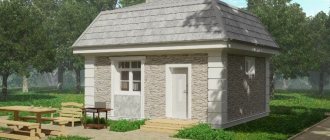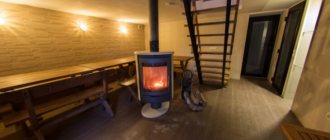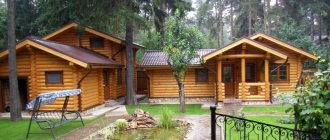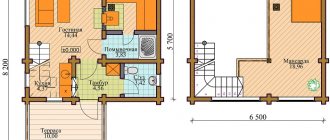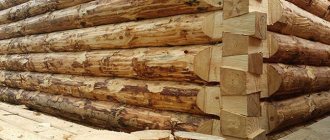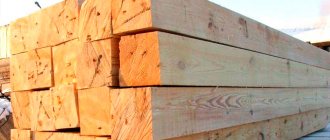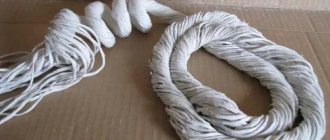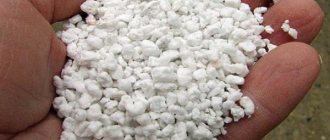Materials used in the construction of roofs and arrangement of premises with non-standard temperature and humidity operating conditions are endowed by manufacturers with special properties. They not only easily resist the attacks of steam-saturated hot air, but also create a “thermos” effect, due to which energy consumption for heating is greatly reduced.
These specific products include foil vapor barrier, the installation of which allows you to solve a lot of important problems in the construction of building structures.
Choosing the best vapor barrier for the roof
- single-layer film - most often this is a simple polyethylene film, the cheapest and most unreliable material. This is not the most durable material on the market.
- reinforced - a stronger material due to the reinforcing middle layer - reinforced mesh. The top of this mesh was covered with polyethylene. This double-sided lamination ensures vapor permeability.
- universal - it is unique in that it is suitable for all structures and works with all types of insulation.
- unreinforced membrane is a multilayer material with high insulating properties, thanks to the foil layer, which copes with its functions perfectly.
Selecting a seal
Let's figure out which seal is suitable for insulation.
- Mineral wool is the most commonly used raw material. It has a number of significant advantages: it perfectly retains heat indoors and also has excellent sound insulation. It is also very easy to use, lightweight, and fire resistant. Release form: slabs and rolls. The advantages of this material also include its quite affordable price, thanks to which it is very popular. However, along with this, there are some disadvantages. Vata has an increased ability to transmit moisture, and it also sags after some time. It is believed that it is best used with horizontal fastening, otherwise it will sag under its own weight. For vertical insulation, it is preferable to use cotton wool in slabs.
- Penofol is the optimal combination of price and quality. However, it is not the main material and is used rather as an addition to the main insulation. It has excellent thermal insulation properties and also prevents the penetration of moisture. It is thin, but at the same time quite dense. Ventilation must be provided to avoid condensation.
- Expanded polystyrene (penoplex) also has good thermal insulation characteristics combined with an affordable price. It does not absorb moisture, that is, at any level of humidity its characteristics remain the same. Expanded polystyrene in granules, poured under the film, perfectly retains heat even in severe frosts.
- Polystyrene foam is easy to install and relatively inexpensive. But as you know, it does not have as high strength as other materials, and it retains heat rather poorly. In this case, it is better to give preference to more reliable raw materials.
- Polyurethane foam is one of the first-class insulation materials with high insulating properties: it fits tightly (does not leave gaps), does not deform over time, and repels moisture well. However, it is possible to insulate an attic in this way only with the help of a specialist who uses a special tool for this.
- Sawdust is an environmentally friendly raw material that has been trusted for many decades. It is very reliable, but after some time its disadvantages also appear: the moisture in them contributes to the development of fungus and rot. They swell from moisture and gain significant weight, while at the same time their heat transfer capacity increases. It is much more advisable to use this material when insulating the floor of an attic space, because it does not accumulate a large amount of moisture.
- Ecowool, on the contrary, is devoid of the disadvantages inherent in sawdust. It does not change its shape, does not rot and is not affected by fungi. Ecowool is considered an excellent material in all respects. The only caveat: you won’t be able to insulate an attic with it yourself. To do this, you need to contact a specialist who will “blow” it under the vapor barrier membrane.
Types of foil insulation and regulations for their use ↑
In addition to wall materials, the use of vapor barrier is regulated by its type, or more precisely, by the material from which it is made.
- Made from kraft paper. Quite a simple and cheap material, but it is subject to mechanical stress and less resistant to moisture.
- Made from polymer materials. This base is resistant to damage, humidity, and temperatures.
- Aluminum spraying. The layer thickness can be 0.3 microns or more. However, thin metallized films play the role of a heat reflector much worse.
- Aluminium foil. Such vapor barrier materials have a metal layer of 10 microns, which makes them resistant to corrosion, and the degree of reflection is about 97%.
You should select foil insulation based on two factors: the type of room, and the types of film itself. Cloths coated with metal foil on a polymer base are best suited for wet bath conditions. And for dry rooms, you can purchase a cheaper option for spraying on paper. Also, the first option, covered with foil, goes well with heated floors.
Vapor control materials on the market
The line includes hydro- and vapor barrier films and superdiffusion membranes. Grand Line H98 film has a number of advantages - the laying pattern, installation side, and overlap boundaries are indicated on the roll. Made from primary raw materials.
Folder products offer several types of material:
- Folder Steam Regulator - this material can provide controlled vapor transmission, maintain the level of vapor barrier and allow excess moisture to pass through as much as possible.
- Alum H90 is a reinforced film with a foil layer that allows you to retain heat in the room and at the same time remove excess moisture.
- H98 – has a laminated layer, can be used with any thermal insulation material.
The Tyvek line includes two vapor barrier membranes:
- Tyvek® AirGuard® Reflective – completely airtight. This membrane was developed to provide more efficient thermal insulation performance. The possibility of condensation entering is minimal.
- Tyvek® AirGuard® SD5 is a material with limited vapor permeability, thereby reducing the risk of condensation and condensation.
- DELTA-DAWI GP is a simple single-layer polyethylene film.
- DELTA-NEOVAP 20 is a film with a reinforcing layer, due to which the risk of damaging the vapor barrier becomes much lower.
- DELTA®-REFLEX PLUS / DELTA®-REFLEX is a film with almost zero vapor permeability. This ensures that condensation does not get on the thermal insulation. This material also reflects heat back into the room.
Icopal Fel'X insulation is a material consisting of three layers - polypropylene, SBS-modified bitumen and a non-woven base. These layers provide strength, waterproofing and protection to the roofing pie.
The assortment includes several products:
- Izospan FS - consists of non-woven dense and metallized polypropylene film. Protects the structure from steam and also reflects heat into the building.
- Izospan B has two layers, the first layer is smooth, the second is rough, capable of holding condensation.
- Izospan D is a membrane that is a two-layer material. Performs the functions of hydro- and vapor barrier. The material is very durable and has high UV stability.
- Izospan DM - this material combines the functions of wind protection, waterproofing and vapor barrier. Consists of three layers.
We suggest you familiarize yourself with: Shelves in a small steam room
One of the economical materials. The line includes Optima B - vapor barrier, Optima C - provides vapor and waterproofing, and Optima D - a universal hydro- and vapor barrier material with increased strength.
A three-layer membrane has high vapor permeability, quickly removes moisture and protects the insulation.
It is a fabric with the addition of a UV stabilizer and a protective layer.
- Ondutis V (R70) Smart is a classic film. Performs all necessary functions, protects the insulation and removes moisture.
- Ondutis D (RV) Smart - this film can be used as a vapor barrier on a warm roof and as a waterproofing on a cold roof.
Advantages of foil vapor barriers ↑
A metallized layer on a vapor barrier base significantly improves the properties of the barrier and gives it tangible advantages over conventional films.
- Low weight. With decent functional properties, foil vapor barrier is lightweight, which does not create large loads on the load-bearing structures of the building.
- Slight thickness. The layer laid on the attic ceiling or ceiling does not in any way affect the volumes or height of the room due to the minimum thickness of the base and the metallized coating itself.
- Ease of use. Vapor barriers with foil can be easily installed on curved contours of buildings and in hard-to-reach places. In addition, it is very easy to make a workpiece of any shape by simply cutting the panel with scissors. You also do not need to have specialized tools and skills to install the insulating layer.
- Temperature stability. The presence of a foil layer makes the vapor barrier less susceptible to high temperatures. And in combination, the film provides maximum protection to structures from high humidity.
- Cleanliness of materials. The production of such insulation does not require toxic materials and compounds that can be released under the influence of heat.
- Versatility. Using the same type of panel, you can insulate various building elements adjacent to the installation site.
Manufactured assortments of reflective vapor barrier can be selected for any room based on the price-quality factor. It will equally have vapor barrier protective properties. And long-term use in conditions of even excessive humidity (typical of a bathhouse) will not lead to the formation of mold and mildew.
But, you can get a fully functioning vapor barrier in a room only taking into account its specifics, and most importantly, compliance with the installation rules.
How to properly install a vapor barrier - basic steps
- Vapor barrier sheets are laid from top to bottom perpendicular to the rafters.
- The material should be rolled out according to the factory winding. Usually the laying side is marked.
- Each subsequent strip must overlap with the previous one.
- All joints must be taped with single- or double-sided tape.
- In places where pipes, risers and other things are bypassed, additional slats can be installed. The overlap of the material should be 10-20 cm.
- The material is attached with a counter-lattice to the rafters. It is acceptable to use nails.
- At the ridge, the overlap of the sheets should be 200 mm. It is better to lay more in the valley - 300 mm, and also on top of the material it is necessary to add an overlay along the entire width of the valley.
- The ventilation gap above the vapor barrier should be from 50 to 100 mm. Vents should be provided in the eaves area.
- It is recommended to minimize the number of holes. All holes must be sealed with tape to ensure the tightness of the entire layer.
- When adjacent to metal or other surfaces, fastening is carried out using double-sided tape.
We invite you to familiarize yourself with: Do-it-yourself pool ladder: how to make a ladder from polypropylene (plastic) pipes, the advantages of double-sided ladders for a frame pool
Price
in the production of foil insulation on the Russian market :
- Jermaflex;
- Izolon;
- Penofol;
- Tepofol;
- Folgoizol;
- Ecofol.
| Firm | Characteristics | Price |
| Jermaflex | 1.2 m x 8 mm | 80 RUR/m² |
| Izolon | Type A, thickness from 2 to 10 mm, length 1 m | 140-260 RUR/m² |
| Penofol | Type A, thickness from 3 to 20 mm, length 36-12 m (the thicker, the shorter the meter) | 53-278 RUR/roll |
| Tepofol | Type A, thickness from 2 to 10 mm, length 2.5 m | 40-1200 RUR/roll |
| Folgoizol | Type A, thickness 10 mm, length 15 m | 1650 RUR/roll |
| Ecofol | Type A, thickness from 2 to 15 mm, length 25-10 m | 780-1030 RUR/roll |
Features of installation of foil vapor barrier ↑
The main task of a vapor barrier is to protect the insulation and walls from moisture penetration inside. This function is the starting point when installing panels in different rooms.
- When assembling a “cold” roofing pie, metallized strips of material are mounted in the ceiling (recommended for the ceiling), from the inside of the room with the foil down.
- If installation is carried out for a house in the attic, then the foil vapor barrier is laid with the metal side inside the room on top of the laid insulation on the inside of the roof slopes. Fix the film with a stapler and counter-lattice slats.
- In the bathhouse, foil vapor barrier is installed on all planes, on the floor, walls and ceiling. The foil surface is turned inside the room.
Important
If you confuse the back and front sides of the foil vapor barrier, then all the moisture will end up inside the walls and insulation.
montaj-1
montaj-2
- All wooden parts of rafter systems and other building elements should be carefully inspected for protruding sharp edges or fasteners to avoid damage to the film during installation.
- Before you begin installing the insulation, you should treat all wooden parts of the structure with an antiseptic. This will extend the life of the material and is guaranteed to eliminate problems such as the formation of fungus and mold.
- Vapor barrier layers on any planes (roof slopes, walls, interfloor ceilings) must be continuous. The porous structure does not require ventilation gaps. The mounted panels are connected hermetically using foil tape.
- Laying of vapor barrier is carried out only in a horizontal position, according to the scheme from top to bottom. That is, the first strip is mounted near the ridge, the second lies lower, overlapping the first.
- When laying sheets of material, releases are made on walls and other nearby areas. The width of such strips should be at least 150-200 mm.
- Fastening in attics, attics and ceilings is carried out with a stapler. Additional fixation is performed with sheathing slats, which can later be used as a base for the internal cladding.
- All joints of the panels are taped with foil tape.
We invite you to read: A bathhouse is an outbuilding
. Advice
It is worth knowing that when installing foil vapor barrier options, it is best to use additional materials from the same manufacturer as the film. It is better not to experiment with other adhesive tape options not recommended by the manufacturer.
Foil vapor barrier is a specific material, but it is recommended to use it to improve the energy-saving properties of premises. However, in order to effectively use such films, you need to take into account their characteristics, as well as the conditions of a particular room. It is not economically feasible to use metallized vapor barrier in interior rooms without the formation of high temperatures and high humidity. Conversely, for an attic or bathhouse, it is best to use precisely those layers of vapor barrier where they will be fully effective.
Dew point problem
Ideally, the roof in the attic should be insulated from the outside at the stage of forming the roofing pie. However, often this is done the other way around from the inside, when the house is already covered with a roof. And here certain problems arise.
The correct and ideal roofing pie is several layers of different materials laid on top of the rafters tightly on top of each other without gaps. Such a sandwich ensures that the dew point will be located on its outer side. As a result, all condensate formed outside will quickly evaporate into the atmosphere.
By doing insulation from the inside, after installing the roof, it is impossible to form the exemplary roofing pie described above. It will not be possible to press the insulation onto the roof so that there are no voids left between them.
But steam always moves towards cold air. And then, each of the formed cavities will begin to accumulate condensation and moisture. And this is a direct path to damage to the thermal insulation material and wooden elements of the rafter system.
When insulating an attic internally, the dew point has to be shifted into the space between the laid roof and the insulation, leaving an additional 5–10 cm gap there for ventilation. Only such a technology and such a cake will avoid moisture in the insulating material.
To reduce the amount of water vapor in the insulation, its installation should be done using a vapor barrier film. A vapor barrier is installed from the inside of the attic on top of the thermal insulation material.
The steam must first encounter this film and mostly remain in the room. The less of it gets into the insulation layer, the better.
Installation of vapor barrier on different surfaces
Vapor barriers can be installed on different surfaces.
For example, for the floor. In this case, the material is placed inside out against the floor beams. Vice versa for the ceiling. The film is unrolled and installed with the rough side inward.
Can be installed on walls. In this case, the following rules apply:
- you need to unroll the film on the wall and secure it with staples,
- vapor barrier sheets must overlap 100-200 mm,
- Excessive tension should be avoided,
- it is necessary to provide space for ventilation,
- as in the roofing version, all joints must be taped with single-/double-sided tape to ensure complete sealing.
When installing a vapor barrier on wooden structures, the wood must be pre-treated with an antiseptic.
Important! Installation should not be carried out in wet or rainy weather. The vapor barrier material must be dry.
Most often, the manufacturer provides instructions for proper installation along with the material, and these instructions should be used. Rolls should be stored on pallets at a distance from heating devices, indoors or under a canopy. No more than 25 rolls can be stored on one pallet. Rolls are also transported on pallets in closed vehicles.
Insulating the attic roof
Guide on how to insulate an attic roof:
- A layer of waterproofing is laid on the sheathing under the roof, along the rafters along the entire height of the roof of the building, right up to the ridge. The film is pressed with bars, forming ventilation ducts up to 5 cm high between the sheathing and the insulation. The waterproofing is attached with a sag of 2 cm to prevent rupture due to temperature changes at the fastening points. To ensure free movement of air, break the film near the ridge at a distance of 5-10 cm from it.
- The insulation material is cut into slabs that are 4-5 cm shorter than the height of the rafters. The thickness of the insulation is selected based on the climate.
Insulation of an attic roof must include ventilation gaps to prevent the occurrence of excessive moisture under the roof. In winter, ventilation gaps prevent heating of the roof covering, and, consequently, the formation of an ice crust. In summer, they help avoid overheating of the living space in the attic.
